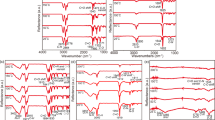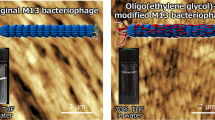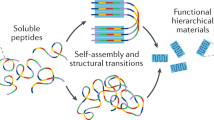Abstract
The goal in biomaterial surface modification is to retain a material's bulk properties while modifying only its surface to possess desired recognition and specificity. Here we develop a unique strategy for surface functionalization of an electrically conductive polymer, chlorine-doped polypyrrole (PPyCl), which has been widely researched for various electronic and biomedical applications. An M13 bacteriophage library was used to screen 109 different 12-mer peptide inserts against PPyCl. A binding phage (ϕT59) was isolated, and its binding stability and specificity to PPyCl was assessed using fluorescence microscopy and titer count analysis. The relative binding strength and mechanism of the corresponding 12-mer peptide and its variants was studied using atomic force microscopy and fluorescamine assays. Further, the T59 peptide was joined to a cell adhesive sequence and used to promote cell attachment on PPyCl. This strategy can be extended to immobilize a variety of molecules to PPyCl for numerous applications. In addition, phage display can be applied to other polymers to develop bioactive materials without altering their bulk properties.
This is a preview of subscription content, access via your institution
Access options
Subscribe to this journal
Receive 12 print issues and online access
$259.00 per year
only $21.58 per issue
Buy this article
- Purchase on Springer Link
- Instant access to full article PDF
Prices may be subject to local taxes which are calculated during checkout






Similar content being viewed by others
References
Zhang, S. & Altman, M. Peptide self-assembly in functional polymer science and engineering. React. Funct. Polym. 41, 91–102 (1999).
Valuev, I. L., Chupov, V. V. & Valuev, L. I. Chemical modification of polymers with physiologically active species using water-soluble carbodiimides. Biomater. 19, 41–43 (1998).
Xiao, S. J., Textor, M. & Spencer, N. Covalent attachment of cell-adhesive, (Arg-Gly-Asp)- containing peptides to titanium surfaces. Langmuir 14, 5507–5516 (2000).
Shakesheff, K., Cannizzaro, S. & Langer, R. Creating biomimetic micro-environments with synthetic polymer-peptide hybrid molecules. J. Biomater. Sci. Polym. E 9, 507–518 (1998).
Tong, Y. W. & Shoichet, M. S. Peptide surface modification of poly(tetrafluoroethylene-co-hexafluoropropylene) enhances its interaction with central nervous system neurons. J. Biomed. Mater. Res. 42, 85–95 (1998).
Hrkach, J., Ou, J., Lotan, N. & Langer, R. Poly (L-lactic acid-co-amino acid) graft copolymers. J. Mater. Sci. Res. 78, 92–102 (1999).
Cook, A. D., Pajvani, U. B., Hrkach, J. S., Cannizzaro, S. M. & Langer, R. Colorimetric analysis of surface reactive amino groups on poly(lactic acid-co-lysine):poly(lactic acid) blends. Biomater. 18, 1417–1424 (1997).
Kubies, D., Rypacek, F., Kovarova, J. & Lednicky, F. Microdomain structure in polylactide-block-poly(ethylene oxide) copolymer films. Biomater. 21, 529–536 (2000).
Mori, T. Cancer-specific ligands identified from screening of peptide-display libraries. Curr. Pharm. Des. 19, 2335–2343 (2004).
Rowley M. J., O'Connor, K. & Wijeyewickrema, L. Phage display for epitope determination: A paradigm for identifying receptor-ligand interactions. Biotechnol. Annu. Rev. 10, 151–88 (2004).
Whaley, S. R., English, D. S., Hu, E. L., Barbara, P. F. & Belcher, A. M. Selection of peptides with semiconductor binding specificity for directed nanocrystal assembly. Nature 405, 665–668 (2000).
Flynn, C. E. et al. Synthesis and organization of nanoscale II VI semiconductor materials using evolved peptide specificity and viral capsid assembly. J. Mater. Chem. 13, 2414–2421 (2003).
Sano, K. & Shiba, K. A hexapeptide motif that electrostatically binds to the surface of titanium. J. Am. Chem. Soc. 125, 14234–14235 (2003).
Sarikaya, M., Tamerler, C., Jen, A. K., Schulten, K. & Baneyx F. Molecular biomimetics: nanotechnology through biology. Nature Mater. 2, 577–585 (2003).
Sarikaya M., Tamerler C., Schwartz D. T. & Baneyx F. Materials assembly and formation using engineered polypeptides. Annu. Rev. Mater. Res. 34, 373–408 (2004).
Adey, N. B., Mataragnon, A. H., Rider, J. E., Carter, J. M. & Kay, B. K. Characterization of phage that bind plastic from phage-displayed random peptide libraries. Gene 156, 27–31 (1995).
Berglund, J., Lindbladh, C., Nicholls, I. A. & Mosbach, K. Selection of phage display combinatorial library peptides with affinity for a yohimbine imprinted methacrylate polymer. Anal. Commun. 35, 3–7 (1998).
Konturri, K., Pentti, P. & Sundholm, G. Polypyrrole as a model membrane for drug delivery. J. Electroanal. Chem. 453, 231–238 (1998).
Schmidt, C. E., Shastri, V. R., Vacanti, J. P. & Langer, R. Stimulation of neurite outgrowth using an electrically conducting polymer. Proc. Natl Acad. Sci. USA 94, 8948–8953 (1997).
Valentini, R. F., Vargo, T. G., Gardella, J. A. Jr. & Aebischer, P. Electrically conductive polymeric susbtrates enhance nerve fibre outgrowth in vitro. Biomater. 13, 183–190 (1992).
Vidal, J. C., Garcia, E. & Castillo, J. R. In situ preparation of a cholesterol biosensor: entrapment of cholesterol oxidase in an overoxidized polypyrrole film electrodeposited in a flow system: Determination of total cholesterol in serum. Anal. Chim. Acta. 385, 213–222 (1999).
Cui, X., Hetke, J. F., Wiler, J. A., Anderson, D. J. & Martin, D. C. Electrochemical deposition and characterization of conducting polymer polypyrrole/PSS on multichannel neural probes. Sensors Actuat. A 93, 8–18 (2001).
Wang, L., Li, X. & Yang, Y. Preparation, properties and applications of polypyrroles. React. Funct. Poly. 47, 125–139 (2001).
Sutar, D., Menon, R. & Subramanyam, S. V. Study of electrical conduction in polypyrrole by varying doping level. Thin Solid Films. 417, 40–42 (2002).
Silk, T., Hong, Q., Tamm, J. & Compton, R. G. AFM studies of polypyrrole film surface morphology I. The influence of film thickness and dopant nature. Synth. Met. 93, 59–64 (1998).
Collier, J. H., Camp, J. P., Hudson, T. W. & Schmidt, C. E. Synthesis and characterization of polypyrrole-hyaluronic acid composite biomaterials for tissue engineering applications. J. Biomed. Mater. Res. 50, 574–584 (2000).
Diaz, A. F., Castillo, J. A., Logan, J. A. & Lee, W. Y. Electrochemistry of conductive polypyrrole films. J. Electroanal. Chem. 129, 115–132 (1981).
Tamm, J., Hallik, A., Alumaa, A. & Sammelselg, V. Electrochemical properties of polypyrrole/sulphate films. Electrochim. Acta 42, 2929–2934 (1997).
Lee, S. -W., Mao, C., Flynn, C. E. & Belcher, A. M. Ordering of quantum dots using genetically engineered viruses. Science 296, 892–895 (2002).
Technical Bulletin E8100, E8110, E8120 1–4 (New England Biolabs, Cambridge, Massachusetts, 2004).
Blackburn, S. Amino Acid Determination: Methods and Techniques 2nd edn, 121–125 (Marcel Dekker, New York, 1978).
Undenfriend, S. et al. Fluorescamine: A reagent for assay of amino acids, peptides, proteins, and primary amines in the picomole range. Science. 172, 871–872 (1972).
Barrett, G. C. & Elmore, D. T. Amino acids and peptides (Cambridge Univ. Press, New York, 1998).
Lee, G. U., Kidwell, D. A. & Colton, R. J. Sensing discrete streptavidin-biotin interactions with atomic force micrscopy. Langmuir 10, 354–357 (1994).
Dammer, U. et al. Specific antigen/antibody interactions measured by force spectroscopy. Biophys. J. 70, 2437–2441 (1996).
Nakamura, C. et al. Mechanical force analysis of peptide interactions using atomic force microscopy. Biopolym. (Peptide Sci.) 76, 48–54 (2004).
Merkel, R., Nassoy, P., Leung, A., Ritchie, K. & Evans, E. Energy landscapes of receptor-ligand bonds explored with dynamic force spectroscopy. Nature 397, 50–53 (1999).
Allison, D. P., Hinterdorfer, P. & Han, W. Biomolecular force measurements and the atomic force microscope. Curr. Opin. Biotech. 13, 47–51 (2002).
Evans, E. Energy landscapes of biomolecular adhesion and receptor anchoring at interfaces explored with dynamic force spectroscopy. Faraday Discuss. 111, 1–16 (1998).
Massia, S. P. & Hubbel, J. A. Covalently attached GRGD on polymer surfaces promotes biospecific adhesion of mammalian cells. Ann. N. Y. Acad. Sci. 589, 261–270 (1988).
Pierschbacher, M. D. & Ruoslahti, E. Cell attachment activity of fibronectin can be duplicated by small synthetic fragments of the molecule. Nature 309, 30–33 (1984).
Hersel, U., Dahmen, C. & Kessler, H. RGD modified polymers: biomaterials for stimulated cell adhesion and beyond. Biomater. 24, 4385–4415 (2003).
Barltrop, J. A., Owen, T. C., Cory, A. H. & Cory, J. G. 5-(3-carboxymethoxyphenyl)-2-(4,5-dimethylthiazoly)-3-(4 sulfophenyl)tetrazolium, inner salt (MTS) and related analogs of 3-(4,5-dimethylthiazolyl)-2,5-diphenyltetrazolium bromide (MTT) reducing to purple water-soluble formazans as cell-viability indicators. Bioorg. Med. Chem. Lett. 1, 611–614 (1991).
Labrou, N. E. Design and selection of ligands for affinity chromatography. J. Chromatogr. B 790, 67–78 (2003).
Jozefonvicz, J. & Jozefowicz, M. Review: Interactions of biospecific functional polymers with blood proteins and cells. J. Biomater. Sci. Polym. E 1, 147–165 (1990).
Lévy, R., & Maaloum, M. Measuring the spring constant of atomic force microscope cantilevers: thermal fluctuations and other methods. Nanotechnol. 13, 33–37 (2002).
Moy, V. T., Florin, E. -L. & Gaub, H. E. Adhesive forces between ligand and receptor measured by AFM. Colloids Surf. A 93, 343–348 (1994).
Acknowledgements
This work was supported by the Gillson Longenbaugh Foundation (C. E. S.) and the Welch Foundation (C. E. S.), the Packard Foundation (A. M. B.) and the National Science Foundation (A. M. B.). The authors wish to thank the Center for Nano and Molecular Science and Technology for use of the AFM, and Wolfgang Frey for helpful discussions on peptide interactions and force spectroscopy. We would also like to thank John Mendenhall and Klaus Linse at the Institute of Cellular and Molecular Biology for their help with confocal microscopy and peptide synthesis (and other peptide related discussions), respectively.
Author information
Authors and Affiliations
Corresponding author
Ethics declarations
Competing interests
The authors declare no competing financial interests.
Supplementary information
Supplementary Information
Supplementary tables I, II and III and detailed methods (PDF 130 kb)
Rights and permissions
About this article
Cite this article
Sanghvi, A., Miller, KH., Belcher, A. et al. Biomaterials functionalization using a novel peptide that selectively binds to a conducting polymer. Nature Mater 4, 496–502 (2005). https://doi.org/10.1038/nmat1397
Received:
Accepted:
Published:
Issue Date:
DOI: https://doi.org/10.1038/nmat1397
This article is cited by
-
Large π-extended donor-acceptor polymers for highly efficient in vivo near-infrared photoacoustic imaging and photothermal tumor therapy
Science China Chemistry (2021)
-
Polypyrrole/functionalized multi-walled carbon nanotube composite for optoelectronic device application
Chemical Papers (2021)
-
Selection and identification of a novel bone-targeting peptide for biomedical imaging of bone
Scientific Reports (2020)
-
Effective gamma-ray sterilization and characterization of conductive polypyrrole biomaterials
Scientific Reports (2018)



